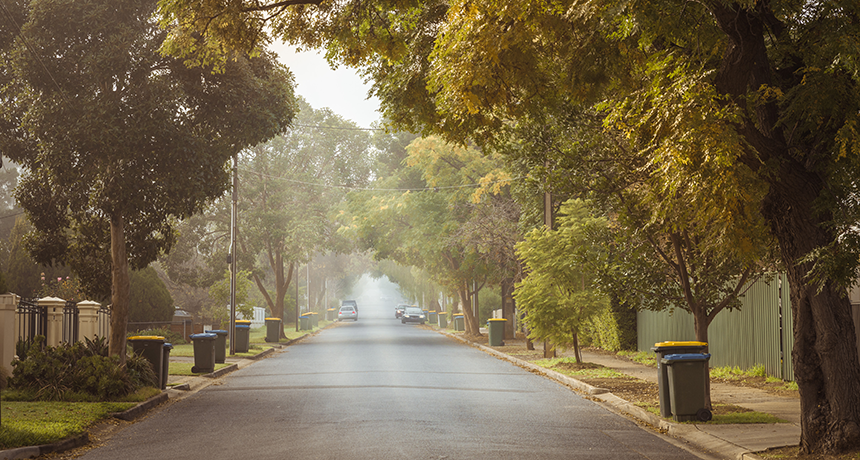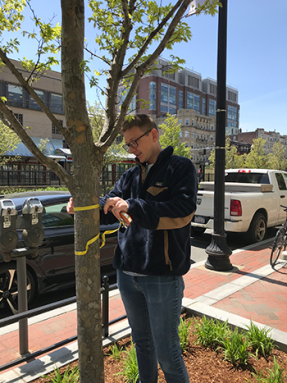City living makes trees grow fast but die young
Urban trees may not remove as much carbon dioxide, a greenhouse gas, as rural trees

Many cities plant trees to absorb CO2 and stop temperatures from rising to dangerous levels. But a new study shows city trees grow faster and die younger than forest trees. That means city trees will absorb less CO2.
mastersky/iStock/Getty Images Plus
City trees grow faster and die younger than trees in rural forests, a new study finds. Over their lifetimes, then, urban trees will likely absorb less carbon dioxide, or CO2, from the air than will forest trees. If confirmed, this trend would be important information for people charged with finding ways to slow global warming.
CO2 is a greenhouse gas, meaning it traps energy from the sun as heat. That makes temperatures near the ground rise. Human activities, especially the widespread burning of fossil fuels, have been releasing extra greenhouse gases into the air. This has led to a rise in average temperatures across the globe.
Trees and other plants remove CO2 from the air as they grow. They store its carbon in their tissues. To absorb CO2 and slow the warming, many cities have been planting trees.
Studies had shown forests readily sop up this gas. But there hadn’t been much data on whether city trees grow, die and absorb CO2 at the same rate that forest trees do. So Lucy Hutyra and her colleagues at Boston University in Massachusetts decided to find out.
Hutyra is an environmental scientist who studies CO2 in the environment. Scientists had assumed city trees were no different from country trees, she says. In fact, her data now show, “Young city trees grow like gangbusters compared to country trees.”
And they die sooner.
The researchers described their findings May 8 in PLOS ONE.
City living — and dying
To figure out how quickly trees were growing, the researchers tracked their diameters (the width of their trunks) between 2005 and 2014. A tree’s diameter increases as it grows, much as a person’s waist size increases as they gain weight. About half the weight of a tree is carbon, research has shown. Most of the rest is water.

The team focused on red oaks and red maples growing on Boston streets. These grew four times faster than did the same species in a nearby forest.
Faster-growing trees absorb more CO2. Over the nine years the researchers tracked these trees, city ones absorbed four times as much carbon from the air as did the forest trees. The city trees also, however, were twice as likely to die. So over the lifetime of each type of tree, forest trees actually absorbed more CO2.
City trees grew faster because they had less competition for light from their neighbors, Hutyra says. In a forest, trees tend to grow close together, shading their neighbors. So few may get as much light as they want.
Street trees also benefit from higher levels of nitrogen in rainwater, says Hutyra. Nitrogen is an element that helps plants grow. It’s also an ingredient of the exhausts that gas-burning cars spew from their tailpipes. That tailpipe pollution enriches city air with nitrogen, she says. Later, rainwater may wash much of it to the ground.
Some street trees also may have better access to water than trees in the country, notes Hutyra. That’s because the underground water pipes can leak.
Still, she cautions that her team’s findings may not hold for arid cities. “Our story is about New England trees,” she says. “In [dry] locations like Phoenix or Los Angeles, city trees might respond differently because it’s extra hot in the city and they have so little water.” At such sites, she says, “Trees might grow slower.”
So why were Boston’s street trees twice as likely as their country cousins to die young?
Roads and sidewalks can leave big-tree roots less room to grow. Cars plow into some trees during fender benders. Plus, homeowners and city planners often decide to take down trees that are sick, unsightly or in the way of some desired structure or view.
Shaun Watmough is an environmental scientist at Trent University in Peterborough, Canada. He says it’s important to keep in mind that people don’t plant city trees along city streets just to sop up carbon. Trees also help clean the air, provide shade and make a city more beautiful, he says — even if it’s only for decades, not centuries.







